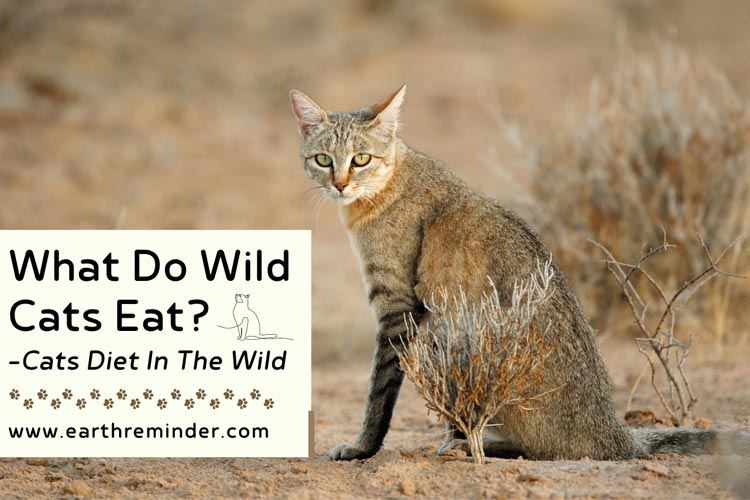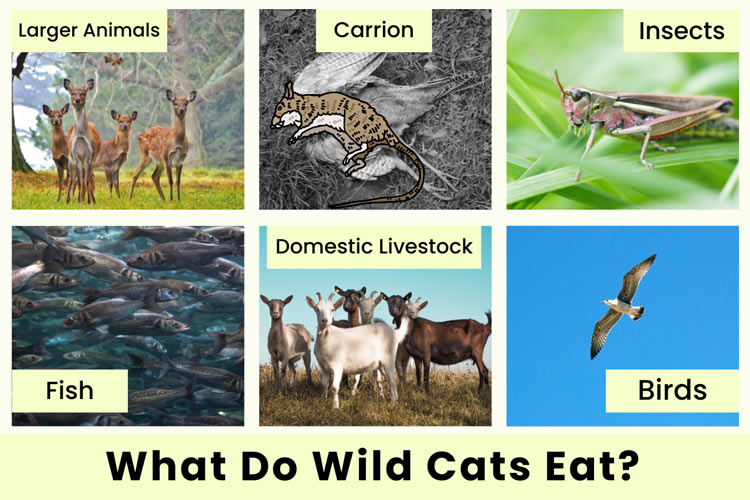What Do Wild Cats Eat? – Cats Diet In The Wild
Wild cats are predators with sharp hunting skills, so their diet plays a crucial role in their survival. Based on their size, habitat, and hunting abilities, these carnivorous animals eat a variety of things. In the wild, cats usually hunt small mammals like rabbits, rodents, and birds, but larger animals like lions and tigers can also kill deer, zebras, and buffalo. We will now look at wild cats diet in order to gain a deeper understanding of what they eat on a regular basis.
It will be interesting for you to know that the original wild ancestors of all domestic cats were the European wildcats, Felis silvestris. All domestic cat breeds are variations of this species. Worldwide, domestic cats are also believed to be descended from African wild cats (Felis silvestris lybica).
Table of Contents
Introduction: Cats Diet In The Wild
Like domestic and feral cats, wild cats only consume other animals for food. The physique of a wildcat is strong, flexible, and robust. As dedicated carnivores, they may consume all the nutrients they need through meat and its by-products. Cats feed primarily on wild rabbits when they are present in the wild. It will be amazing to know what food wild cats eat when there are no rabbits around.
Eventually, our cats will revert to eating what their wild ancestors did centuries ago without our intervention. As genetically, they haven’t evolved much either. Accordingly, domestic cats and wild cats both require similar kinds of food in their diets.
What Do Cats Eat In The Wild?
There are different types of wild cats that have distinct eating habits. They all are carnivorous creatures that depend primarily on meat for nourishment. In the wild, a cat’s diet might vary depending on where it lives, but it typically includes the following:
Prey Animals
Wild cats hunt or consume various prey animals, including rodents, birds, reptiles, amphibians, fish, and insects. Even larger wild cats, including tigers and lions, hunt larger mammals, including deer or buffalo.
Carrion
Wild cats will scavenge and eat carrion if they find it. The remains of other creatures can also be included, whether they died naturally or were killed by predators. Carrion is dead animal flesh that hasn’t been killed for consumption. Cats can get protein and other nutrients from carrion. There is also the risk that the meat might be contaminated with bacteria or other harmful agents.
Fish
Fish is an excellent source of protein, omega-3 fatty acids, and other nutrients. Fishing cats and Jaguars are two examples of wild cats that are believed to catch and consume fish. To capture their prey, they frequently hunt inside or near bodies of water.
Insects
In the wild, cats hunt and consume insects including grasshoppers, crickets, beetles, and caterpillars. Cats also get essential nutrients from insects, such as vitamins and minerals. Wild cats can also get protein from insects. Several animals, like the caracal, are known to regularly consume insects.
Domestic Livestock
Wild cats, especially in rural areas, hunt and eat domestic animals, like chickens, ducks, sheep, goats, and rabbits. Cats display this behavior naturally, but farmers and pet owners may need to adapt to prevent their animals from being preyed on. This can lead to disputes because wild cats are viewed as a threat.
In general, most wild cats eat meat, although the amount may vary depending on the area and prey availability.
What Cats Don’t Eat In The Wild?
Carnivorous wild cats hunt and eat a wide variety of prey, including rodents, birds, reptiles, fish, and insects. However, wild cats do not eat some foods, either because they are toxic or indigestible. Here are some examples of what wild cats do not eat:
- Chocolate: Theobromine, a substance found in chocolate, is poisonous to cats and can cause vomiting, diarrhea, seizures, and even death in some cases.
- Raisins and Grapes: Cats can get kidney failure from grapes and raisins, even if they eat them in small amounts. There is no exact mechanism behind this, but cats should not be given these fruits.
- Garlic and Onions: The compounds in onions and garlic can damage the red blood cells of cats, causing anemia and weakness. This applies to both the raw and cooked forms of these vegetables.
- Plants: A wild cat cannot digest plant matter; they are completely incapable of digesting it. They simply cannot extract energy or nutrients from it. In some cases, cats ingest grass with their prey in the wild. According to studies, wild carnivores regularly eat non-digestible grass to get rid of parasitic worms.
- Bones: Cats can suffer injuries from splintered bones in their mouths, throats, stomachs, and intestines. Additionally, they may cause choking or intestinal blockages. As cats can get calcium from other sources, they do not need bones to get calcium.
- Milk and Dairy Products: In most cases, cats cannot digest milk and dairy products due to lactose intolerance. There is a possibility that this may cause diarrhea, gas, and stomach upset.
What Do Wild Cats Drink?
Wild cats are adapted to surviving in water-scarce environments, such as deserts and savannas. There are several ways they get water to stay healthy. Some of them are as follows:
- Wild cats obtain water from their food’s moisture content. Their prey includes birds, insects, and rodents which contain a lot of water. By doing so, they are no longer required to drink from other sources.
- Local water sources, such as streams and ponds are familiar to wild cats. In order to keep them safe, they usually visit them at dawn or dusk when the weather is cooler and safer.
- It’s possible for wild cats to concentrate their urine to keep themselves hydrated. Their desert ancestors inherited this trait. The downside of this is that they are also prone to kidney problems and bladder infections.
- In order to regulate their body temperature, wild cats pant, lick their fur, or seek shade. By doing this, they can prevent overheating and sweating out water.
Also Read: How Does Energy Flow Through an Ecosystem?
Cats Diet Conclusion
In conclusion, wild cats eat different kinds of prey based on their habitat, hunting skills, and availability. While some wild cats specialize in certain types of prey, others are more opportunistic and adaptable. Cats are innate hunters created to hunt and consume prey in the wild. Cats consume insects, mice, and other tiny creatures in their natural habitat. To aid digestion, they also occasionally eat grass. By controlling their prey populations, wild cats maintain ecosystem balance.
Although wildcats are generally gentle creatures, they can become aggressive when threatened or on the hunt. Be careful when you try to feed them. While cats are well adapted to hunting in the wild, they need the right nutrition and care when they live in a domestic setting.

